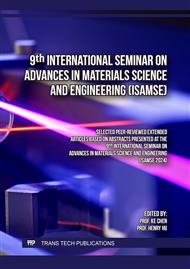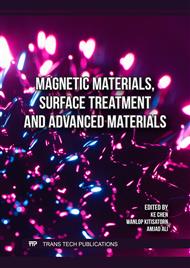[1]
HAN Enhou, CHEN Jianmin, SU Yanjing, et al. Corrosion Protection Techniques of Marine Engineering Structure and Ship Equipment-Current Status and Future Trends. Materials China, 2014, 33(2): 65-76. https://www.cnki.net
Google Scholar
[2]
Glover T J. Copper–Nickel Alloy for the Construction of Ship and Boat Hulls [J]. British Corrosion Journal, 2013, 17(4): 155-158
DOI: 10.1179/000705982798274228
Google Scholar
[3]
MA Aili, ZHANG Yaming, JIANG Shengli, et al. Failure Analysis of a Weld Ring of 90/10 Cupronickel for Marine Pipe Combination [J]. Science and Protection Technology, 2015, 27(5): 473-482. https://www.cnki.net
Google Scholar
[4]
LIN Leyun, XU Jie, ZHAO Yuehong. Study on corrosion behavior of B10(Cu: Ni=90: 10) alloy exposed to natural seawater [J]. Journal of Chinese Society of corrosion and protection. 2000, 20(6): 361-367. https://www.cnki.net/
Google Scholar
[5]
Yikun Cai, Yuanming Xu, Yu Zhao, et al. Quantitative Understanding of the Environmental Effect on B10 Copper Alloy Corrosion in Seawater. metals, 2021, 11(7): 1080-1097
DOI: 10.3390/met11071080
Google Scholar
[6]
Bo Sun, Tianyuan Ye, Qiang Feng, et al. Accelerated Degradation Test and Predictive Failure Analysis of B10 Copper-Nickel Alloy under Marine Environmental Conditions. Materials, 2015, 8(9): 6029-6042
DOI: 10.3390/ma8095290
Google Scholar
[7]
Yuefeng Chen, Bin Yang, Yangtao Zhou, et al. Evaluation of pitting corrosion in duplex stainless steel Fe20Cr9Ni for nuclear power application, Acta Materialia, 2020, 197(9): 172–183
DOI: 10.1016/j.actamat.2020.07.046
Google Scholar
[8]
Kear G, Bearker B D, Stokes K, et al. Electrochemical corrosion behaviour of 90-10 Cu-Ni alloy in chloride-based electrolytes. Journal of Applied Electrochemistry, 2004 (34): 659-669. https://doi.org/10.1023/B: JACH.0000031164.32520.58
DOI: 10.1023/b:jach.0000031164.32520.58
Google Scholar
[9]
Metikoš-Hukoviĉ M, Škugor I, Grubaĉ Z, et al. Complexities of corrosion behaviour of copper-nickel alloys under liquid impingement conditions in saline water. Electrochim Acta, 2010(55): 3123-3129. https://doi.org/
DOI: 10.1016/j.electacta.2010.01.066
Google Scholar
[10]
Yuan S J, Pehkonen S O. Surface characterization and corrosion behavior of 70/30 Cu-Ni alloy in pristine and sulfide-containing simulated seawater. Corrsion science, 2007, (49): 1276-1304
DOI: 10.1016/j.corsci.2006.07.003
Google Scholar
[11]
Ralston K D, Birbilis N, Davies C H J. Revealing the relationship between grain size and corrosion rate of metals [J]. Scripta Materialia, 2010, 63: 1201. https://doi.org/
DOI: 10.1016/j.scriptamat.2010.08.035
Google Scholar
[12]
RU Xiang-kun, LIU Ting-guang, XIA Shuang. Effect of deformation and heat-treatment on grain boundary distribution character of cupronickel B10 alloy [J]. The Chinese Journal of Nonferrous Metals.2013, 23(8): 2176-2181. https://www.cnki.net
Google Scholar
[13]
Michiuchim, Wang Z.J. Twin-induced grain boundary engineering for 316 austenitic stainless steel [J]. Acta mater, 2006, 54(19): 5179-5184. https://doi.org/10.1016/J.ACTAMAT. 2006.06.030
DOI: 10.1016/j.actamat.2006.06.030
Google Scholar
[14]
Jiang Tao, Fu Shaoli, Dong Jianlong. Effect of grain boundary characteristic distribution on corrosion resistence performance of B10 cupronickel [J]. Nonferrous Metal Materials and Engineering. 2023, 44(1): 15-23. https://www.cnki.net/
Google Scholar
[15]
N Wang, Y Shen, Q An. Microstructure evolution and mechanical property of Cu-15Ni-8Sn-0.2Nb alloy during aging treatment [J]. Journal of Materials Science and Technology, 2021, 86: 227-236
DOI: 10.1016/j.jmst.2021.01.034
Google Scholar
[16]
Zhukov A. On the history of detection of spinodal predecomposition of supercooled austenite in bainitic iron-carbon alloys [J]. Metal Science and heat treatment, 2001, 43(1-2): 55-57. https://doi.org/10.1023/A: 1010474307139
Google Scholar
[17]
An Z, Mao S, Yang T, etal. Spinodal-modulated solid solution delivers a strong and ductile refractory high-entropy alloy [J]. Materials Horizons, 2021, 8(3): 948-955
DOI: 10.1039/D0MH01341B
Google Scholar
[18]
P Roberto, D Farkas. Atomistic modeling of dislocations in a random quinary high-entropy alloy [J]. Computational Materials Science, 2020, 173: 109366. https://doi.org/
DOI: 10.1016/j.commatsci.2019.109366
Google Scholar



